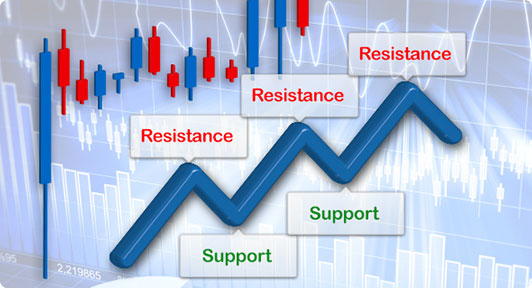 As their names suggest, support and resistance act as barriers within forex markets and are easily spotted on price charts either preventing price from moving higher or lower. This can be seen on any forex chart and across all time frames with those most influential areas of support and resistance potentially still existing in the market years after they were originally created. Both support and resistance in forex trading are known as areas which have historically caused large number of traders to enter the market.
As their names suggest, support and resistance act as barriers within forex markets and are easily spotted on price charts either preventing price from moving higher or lower. This can be seen on any forex chart and across all time frames with those most influential areas of support and resistance potentially still existing in the market years after they were originally created. Both support and resistance in forex trading are known as areas which have historically caused large number of traders to enter the market.
Support is the price zone below the current price where price declines are likely to stop and reverse. Resistance is the prize zone above the current price where price advances are likely to stop and reverse. In an uptrend, price advances are blocked by resistance and price declines are stopped by support. In a downtrend, price declines are blocked by support and price advances are ended by resistance. When prices breaks through resistance they can be expected to rise up to the next level of resistance. If price breaks through support you can expect it to fall down to the next level of support.
Support and resistance levels are calculated based on how prices behaved at specific times in the past and also on how prices tend to behave in general. If currency price failed to break through a certain level in the past, this level can be expected to block price movement in the future. If currency price as a rule finds support or resistance at certain technical analysis tool positions, this can also be used to predict price behavior when these positions are reached. Strongest support and resistance are produced when both measurement methods point in the same direction.
Trading forex using support and resistance can be one of the most effective ways to successfully predict future price movements. Not only do areas of support and resistance show traders the sentiment of the market as a whole, with support and resistance either holding firm or being breached, but it also can show forex traders where not to enter a trade. Support and resistance therefore creates a map of the price chart, showing us where price has previously reversed or bounced and trading strategies can successfully incorporate this knowledge.
Once a resistance or support level is breached, the roles of the resistance and support flip. If the price surges below a support level, that same support level will then become the new resistance level. Conversely, if the price surges above a resistance level, that same resistance will tend to become the new support level. This role reversal will generally only occur once a strong price moved has shifted the price to a new range - often caused by major news or economic reports.







